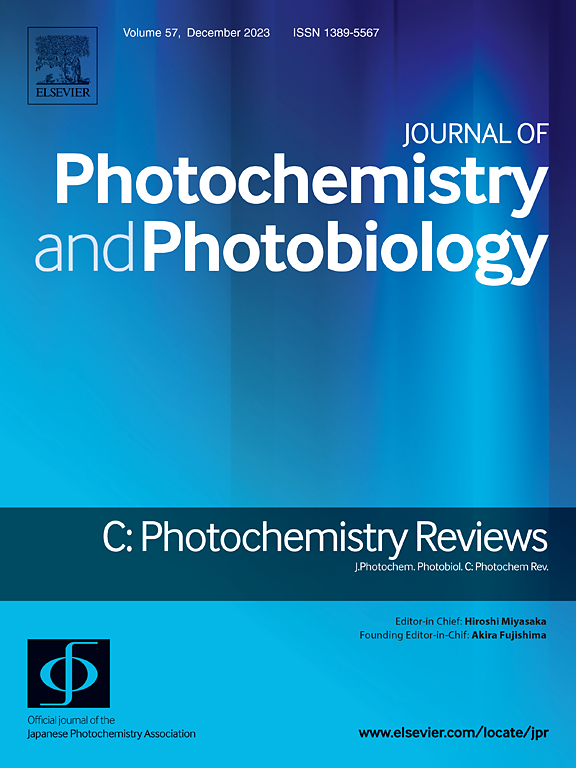Engineering ZnS quantum dots for photocatalysis: Synthesis, modifications, and multifunctional applications
IF 13.1
1区 化学
Q1 CHEMISTRY, PHYSICAL
Journal of Photochemistry and Photobiology C: Photochemistry Reviews
Pub Date : 2025-09-17
DOI:10.1016/j.jphotochemrev.2025.100722
引用次数: 0
Abstract
Photocatalysis is an advanced technology that efficiently converts solar energy into chemical energy, attracting widespread attention in environmental remediation, energy development, and biomedical applications. ZnS quantum dots (ZnS QDs), as a representative wide-bandgap semiconductor, exhibit unique quantum confinement effects, tunable optoelectronic properties, and a high specific surface area, making them a promising metal sulfide photocatalyst. This review systematically summarizes recent advances in ZnS QD-based photocatalytic systems, with a focus on material design strategies and multifunctional applications. First, the fundamental mechanisms of ZnS QDs in photocatalysis are introduced, followed by a discussion on their synthesis methods. Several strategies for enhancing the photocatalytic activity of ZnS QDs, including surface modification, elemental doping, heterojunction formation, and coupling with carbon or organic materials, are discussed in detail. Furthermore, we comprehensively review the applications of ZnS QDs in the photocatalytic degradation of pollutants, water splitting for H2 production, CO2 reduction, N2 fixation, antimicrobial activity, and organic synthesis, highlighting their breakthroughs in biomedical field, such as near-infrared-activated antimicrobial systems and tumor-specific photodynamic/photothermal therapy. Finally, by analyzing the current challenges of ZnS QDs in photocatalysis, we propose three future research directions to promote their practical applications in sustainable energy, environmental restoration, and precision medicine.
用于光催化的工程ZnS量子点:合成、修饰和多功能应用
光催化是一种将太阳能高效转化为化学能的先进技术,在环境修复、能源开发和生物医学应用等方面受到广泛关注。ZnS量子点(ZnS QDs)作为宽带隙半导体的代表,具有独特的量子约束效应、可调谐的光电性能和高比表面积,是一种很有前途的金属硫化物光催化剂。本文系统地综述了基于ZnS量子点的光催化体系的最新进展,重点介绍了材料设计策略和多功能应用。首先介绍了ZnS量子点在光催化中的基本机理,然后讨论了它们的合成方法。详细讨论了提高ZnS量子点光催化活性的几种策略,包括表面改性、元素掺杂、异质结的形成以及与碳或有机材料的偶联。此外,我们全面综述了ZnS量子点在光催化降解污染物、水裂解制氢、CO2还原、N2固定、抗菌活性和有机合成等方面的应用,重点介绍了其在近红外激活抗菌系统和肿瘤特异性光动力/光热治疗等生物医学领域的突破。最后,通过分析目前ZnS量子点在光催化方面面临的挑战,提出了未来的三个研究方向,以促进其在可持续能源、环境修复和精准医疗方面的实际应用。
本文章由计算机程序翻译,如有差异,请以英文原文为准。
求助全文
约1分钟内获得全文
求助全文
来源期刊
CiteScore
21.90
自引率
0.70%
发文量
36
审稿时长
47 days
期刊介绍:
The Journal of Photochemistry and Photobiology C: Photochemistry Reviews, published by Elsevier, is the official journal of the Japanese Photochemistry Association. It serves as a platform for scientists across various fields of photochemistry to communicate and collaborate, aiming to foster new interdisciplinary research areas. The journal covers a wide scope, including fundamental molecular photochemistry, organic and inorganic photochemistry, photoelectrochemistry, photocatalysis, solar energy conversion, photobiology, and more. It provides a forum for discussing advancements and promoting collaboration in the field of photochemistry.

 求助内容:
求助内容: 应助结果提醒方式:
应助结果提醒方式:


